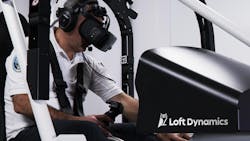FAA taps Loft Dynamics' VR flight simulators to advance helicopter training
ZURICH - Loft Dynamics, an aviation virtual reality (VR) simulation company in Zurich announced a partnership with the Federal Aviation Administration (FAA). Loft Dynamics' simulators are now undergoing U.S. evaluation by the FAA and have previously been approved by European regulator EASA . The FAA has selected Loft Dynamics' Airbus H125 and Robinson R22 simulators to explore the use of VR flight simulation technology to train pilots. Both simulators have been installed at the William J. Hughes Technical Center (WHTC) at Atlantic City, N.J.'s international airport. The WHTC hosts the FAA's innovation hub, where the simulators will be used to advance national aviation safety, efficiency, capacity, and environmental sustainability goals, and to drive the evolution of the National Airspace System (NAS) toward the Next Generation Air Transportation System (NextGen).
"The adoption of VR flight simulators by international safety agencies like EASA and FAA is crucial given the current landscape. The world needs more than 600,000 new pilots in the next 20 years, and the emergence of electric vertical takeoff and landing vehicles (eVTOL) will significantly add to that demand. Traditional training options absolutely cannot keep up. We need innovation to solve this quickly, and that's what we're on a mission to do," said Fabi Riesen, founder and CEO of Loft Dynamics. "To receive approval from EASA and now introduce our technology to the FAA is an exciting and important milestone. We're thrilled to kick off this partnership and collectively forge a safer, more scalable, and sustainable future for U.S. aviation."
The unique features and capabilities of Loft Dynamics' simulators allow the FAA to perform the research and development required to enhance vertical flight safety, pursue qualification under 14 CFR part 60, and advance NextGen goals. The newly installed Robinson R22 (EASA-qualified FNPT) and the Airbus H125 (EASA-qualified FTD Level 3) simulators feature:
- Full-scale replica cockpit and 360-degree view for precise visual cues inside and outside the aircraft.
- Realistic flight model for accurate studies of nominal and off-nominal events and development of safety metrics dependent on rotorcraft aerodynamics.
- Six-degrees-of-freedom motion platform replicating haptic sensations, including sling loads, runway texture, and force feedback from flight controls.
- Adaptable software for customizable training scenarios that mirror any real-world encounter, terrain, and maneuver—risk-free.
- Compact size, 10 times smaller than traditional full-motion simulators.
